GEOL 101: Final Exam Review
Mauna Loa, Hawaii

Identify the rock type you see at this location.
Igneous extrusive rock (basalt).
Most of the land mass of Hawaii is basaltic lava.
How did this rock form?
Basalt forms through volcanic activity (lava cools and solidifies on the Earth's surface).
Shield volcano, characterized by its gentle slopes formed by layers of basaltic lava flows.
How does this rock and landscape fit into plate tectonics?
Hot-Spot: a stationary point of volcanic activity beneath the Earth's crust.
What resources or hazards are associated with this location?
Hazards: Lava flows, volcanic activity, volcanic gas emissions, earthquakes
Resources: Land mass
Yosemite National Park
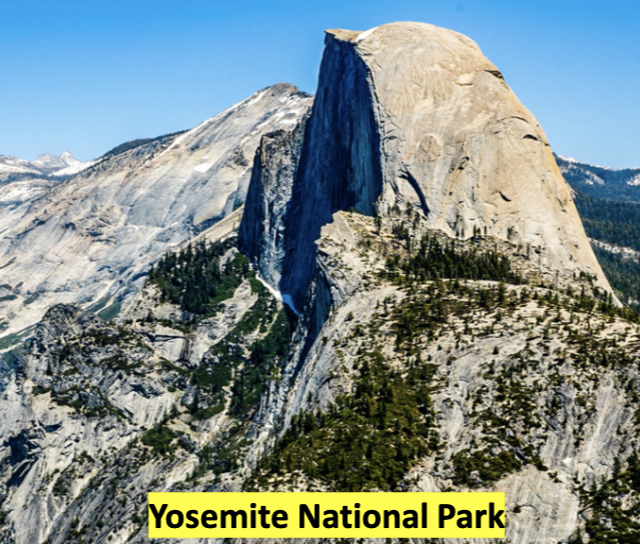
Identify the rock type you see at this location.
Intrusive igneous rock: Granite, diorite
The dominant rock type in Yosemite National Park is granite.
How did this rock form?
Granite forms through slow cooling and solidification of magma beneath the Earth's surface.
How does this rock and landscape fit into plate tectonics?
Convergent plate boundaries (Subduction)
Uplift and erosion exposed these rocks creating features
What resources or hazards are associated with this location?
Hazards:
Rockfalls due to the steep cliffs and weathering of the granitic rock.
Wildfires are another hazard, particularly during dry periods
Occasional earthquakes due to proximity to tectonic plate boundaries.
Resources:
Drinking water
Mount St. Helens
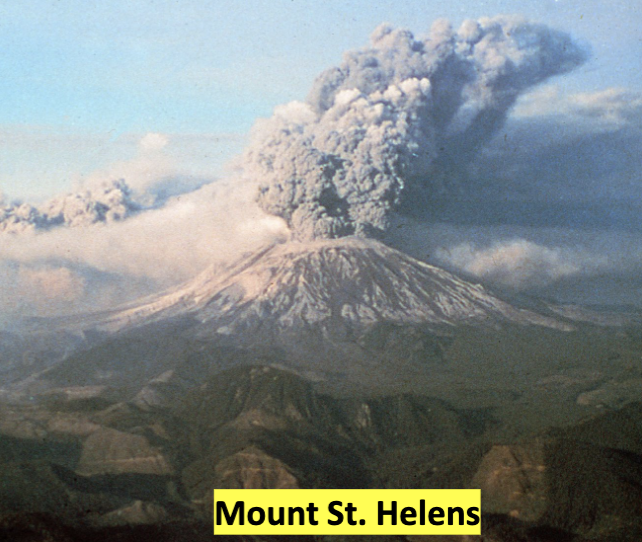
Identify the rock type you see at this location.
Extrusive igneous rock
Basalt (most common), andesite, dacite, and rhyolite.
How did this rock form?
Volcanic activity.
Basalt = effusive eruptions (lava flows out relatively calmly)
Andesite, dacite, and rhyolite = explosive eruptions (magma is thicker)
How does this rock and landscape fit into plate tectonics?
Convergent plate boundaries (Subduction)
What resources or hazards are associated with this location?
Hazards:
Eruptions and volcanic events (resulting in loss of life, destruction of property, and significant environmental impacts)
Lahars (mudflows), pyroclastic flows, ashfall, and volcanic gases.
Resources:
Timber
Minerals
Spring Mountains NRA
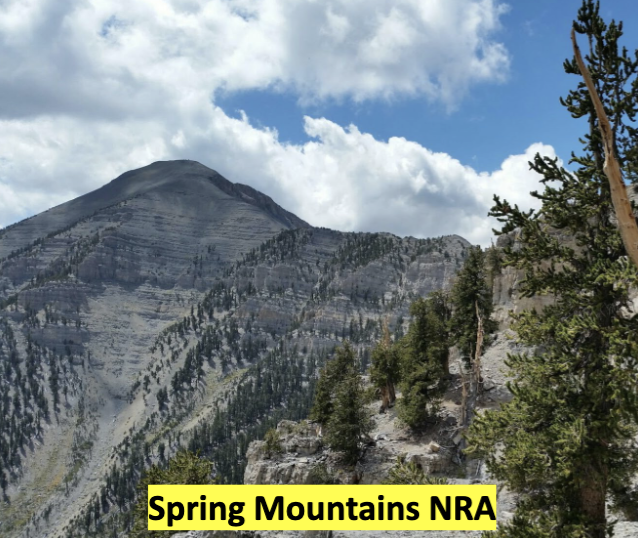
Identify the rock type you see at this location.
Sedimentary rock
Limestone, sandstone, shale, and dolomite
How did this rock form?
Sedimentary processes.
Limestone and dolomite are primarily composed of calcium carbonate deposited by marine organisms, while sandstone forms from the compaction and cementation of sand grains.
How does this rock and landscape fit into plate tectonics?
Divergent plate boundaries (Rift Zones)
Uplift and faulting associated with nearby fault systems such as shear zones.
What resources or hazards are associated with this location?
Hazards:
Flash floods in narrow canyons, due to intense rainfall events common in the region.
Wildfires during hot, dry periods.
Rockfall and landslides can occur in steep terrain, posing risks to visitors and infrastructure.
Resources
Plant study, ecosystems
Red Rock NCA
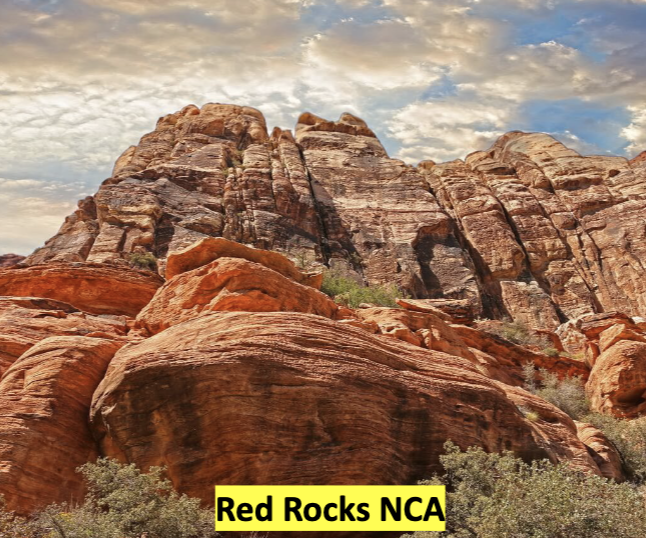
Identify the rock type you see at this location.
Sedimentary rock
Sandstone, limestone, and conglomerate.
How did this rock form?
Sedimentary processes. Sandstone is composed of sand grains cemented together, limestone is primarily calcium carbonate deposited by marine organisms, and conglomerate consists of rounded gravel and pebbles cemented together.
How does this rock and landscape fit into plate tectonics?
Divergent Plate boundaries (Rift Zones)
Uplift and faulting associated with nearby fault systems
What resources or hazards are associated with this location?
Hazards:
Flash floods are a significant risk, particularly in narrow canyons, due to intense rainfall events common in the region.
Rockfall and landslides can occur in steep terrain.
Resources:
Water, wildlife
Grand Teton NP
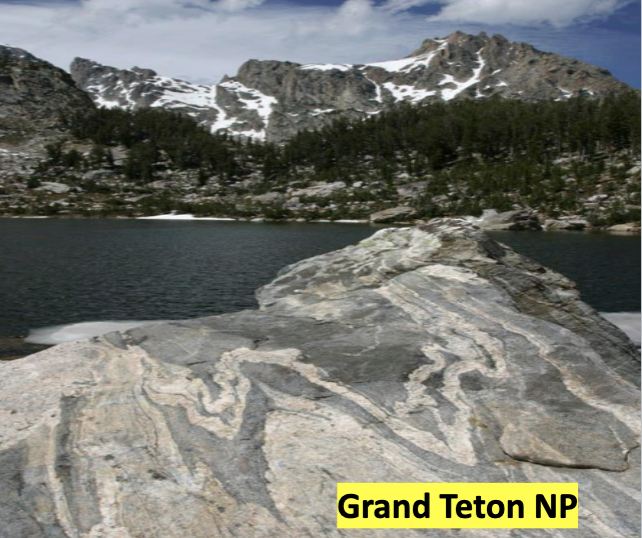
Identify the rock type you see at this location.
Igneous rock and metamorphic rock
Predominant rock types: granite, gneiss, and sedimentary rocks such as limestone and sandstone.
How did this rock form?
Granite, gneiss, and schist formed through igneous and metamorphic processes, deep within the Earth's crust.
Sedimentary rocks like limestone and sandstone formed from the accumulation and compression of sediment over millions of years.
How does this rock and landscape fit into plate tectonics?
Convergent uplifting
Stretching of the Earth's crust has created numerous mountain ranges and valleys.
What resources or hazards are associated with this location?
Hazards:
Rockfalls and avalanches
Weather extremes including thunderstorms, lightning, and snowstorms.
Resources
Wetlands
Wildlife
Chapter 12: Riches in Rock
Energy sources and general amounts (3)
Energy resource: matter that can produce heat, generate electricity, or move machinery.
Human energy needs have greatly increases in the past 150 years.
U.S. production of renewable energy is ~25% higher.
Formation of hydrocarbons (oil and gas) (7, 11)
Industrial society depends on hydrocarbons from oil and natural gas.
Hydrocarbons = hydrogen (H) and carbon (C)
Derive from the material that composed once living creatures.
Always form in sedimentary rocks, called the source rock.
Cook the organic layer: kerogen → oil → gas
As organic rich sediment is buried, burial follows the geothermal gradient (25° C per km).
Burial depth of 2-4 km and 50°C, heat and pressure transform the sediment into black shale and breaks the organic matter into kerogen, the precursor to oil.
With continued burial, kerogen is broken down into hydrocarbons (oil and gas).
Oil window: gas forms when oil breaks down, with burial depth between 3.5-9 km and between 150-225°C.
Above 225°C, organic matter loses all its hydrogen and transforms into graphite, pure carbon.
Migration of hydrocarbons - source rock, reservoir rock, trap (13)
Hydrocarbons migrate away from the source rocks and are trapped in a reservoir rock.
Source rock: where organic material was originally deposited.
Reservoir rock: where the hydrocarbons migrate up to and are stored.
They migrate the same as groundwater - porosity and permeability.
Porosity: open pore space within a rock.
Permeability: the ease of fluid flow through a rock (due to the degree to which pores are connected).
Seals - structural vs. stratigraphic vs. none (15, 16, 17)
Stratigraphic Seals
Salt-dome traps: formed when deeply buried salt flows like a plastic. Less dense than overlying rock, salt will flow upward and deform overlying strata.
Stratigraphic trap: oil and gas collect where the reservoir layer pinches out.
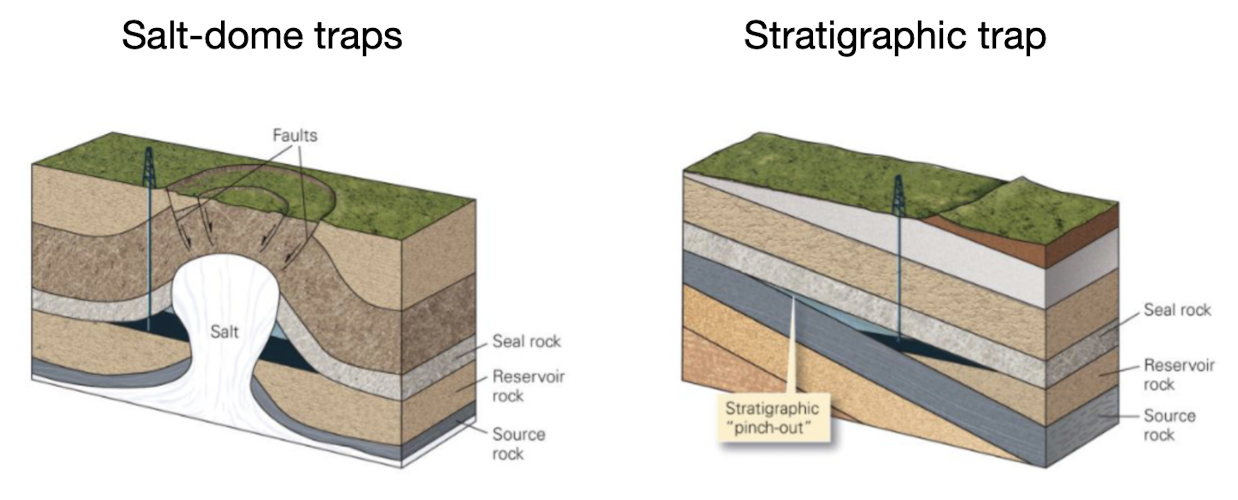
Structural Seals
Fault trap: oil and gas collect in the tilted strata adjacent to the fault.
Anticline trap: oil and gas rises to the crest of the fold.
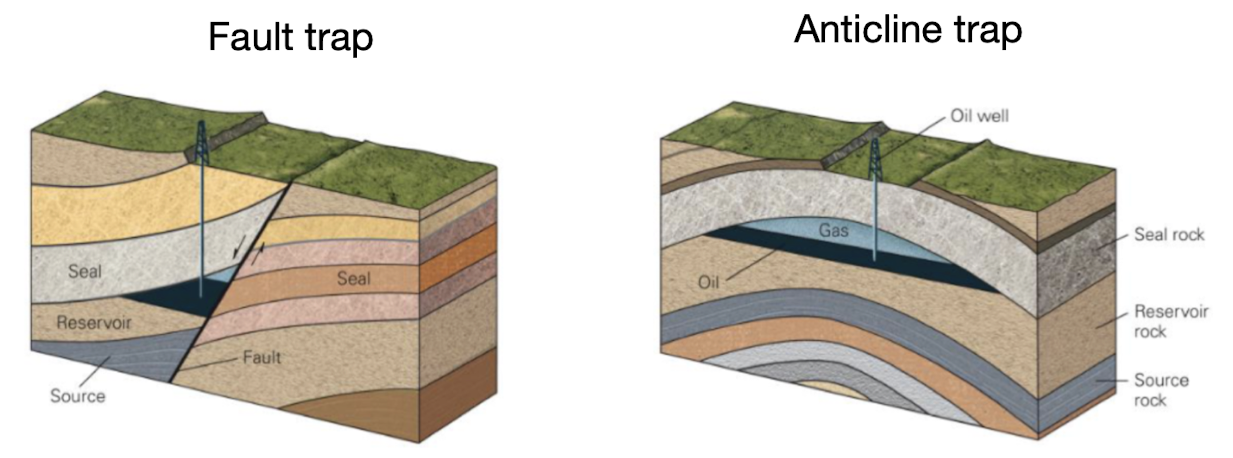
No seal/ no trap
Reservoirs leak to form an oil seep at the surface.
Humans used oil from seeps.
Examples: La Brea Tar Pits, Canada oil sands
Drilling for hydrocarbons (23, 24)
Vertical drilling:
Drilling required to tap into potential trap.
Rotary pulverizes rock, while high density mud cools and lubricates the bit and lifts cuttings out of the hole.
The heavy mud stymies the hydrocarbons when encountered so they don’t come up the hole, reduces the risk of hight pressure blowouts.
When balance is disturbed (pressure from hydrocarbons is greater than mud), blowouts occur (environmental disasters).
Steel casing is cemented to the upper 1,500 ft (or more) of the borehole to protect aquifers and surface water supplies.
Horizontal drilling/ directional drilling
Used for hydraulic fracturing (fracking)
Horizontal wells fracture the rock apart with a slurry to release more hydrocarbons.
The driller steers the bit to run along the seem, this allows rigs to drill deep away from the rig and under property.
A reignition of drilling in previously tapped out ares, using this method had provided a rejuvenation of resources.
Marcellus Shale
Bakken Shale
Barnett Shale

Refining (30)
Crude oil must be refined.
Its heated in a furnace and sent into a distillation column, which works by gravity.
Lighter molecules rise to the top of distillation columns.
Heavier molecules remain at the bottom.
Largest molecules at bottom are used for manufacturing plastics.
Takes a lot of energy from fossil fuels.
Coal usage (38)
Almost every continent has coal reserves.
Coal emits CO2.
United States was largest until China’s use exceeded our own.
Today, the amount of coal consumed globally is increasing.
China and India account for increasing coal consumption.
China’s usage has tripled due to rapid industrialization.
United States relies more on natural gas (32% of electricity is generated this way).
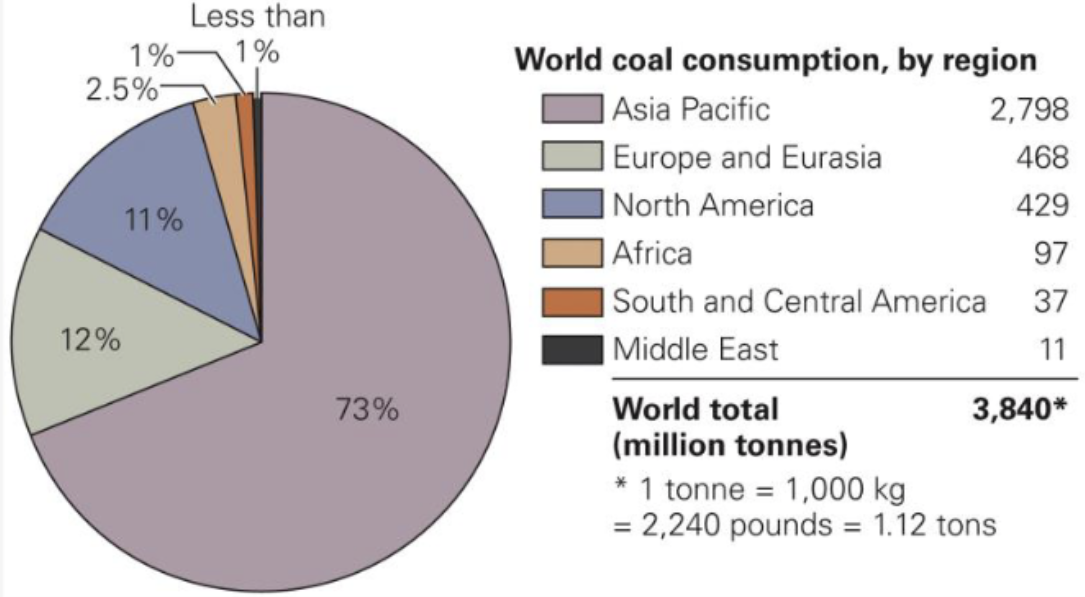
Coal formation (41)
Dead vegetation in swampy stagnant, oxygen poor water causes decay which turns to peat.
Burial to depths of 4-10 km compacts and heats the peat.
Chemical reactions drive off hydrogen, nitrogen, and sulfur as gases.
The remaining residue, coal, is greater than 70% carbon (C).
KNOW THE FLOW: Peat → Lignite → Subsidence → Bituminous

Fossil fuel reserves (51)
How long will fossil fuel resources last?
Humanity faces many changes as oil, gas, and coal are finite.
35 billion barrels of oil consumed each year, oil will not last more than 50 to 100 years.
Same with natural gas.
Coal will last longer, but not much more than 100 years.
Most used metals (58)
Most used metal: Iron ore
Top 5: Iron, aluminum, chromium, copper, and manganese.
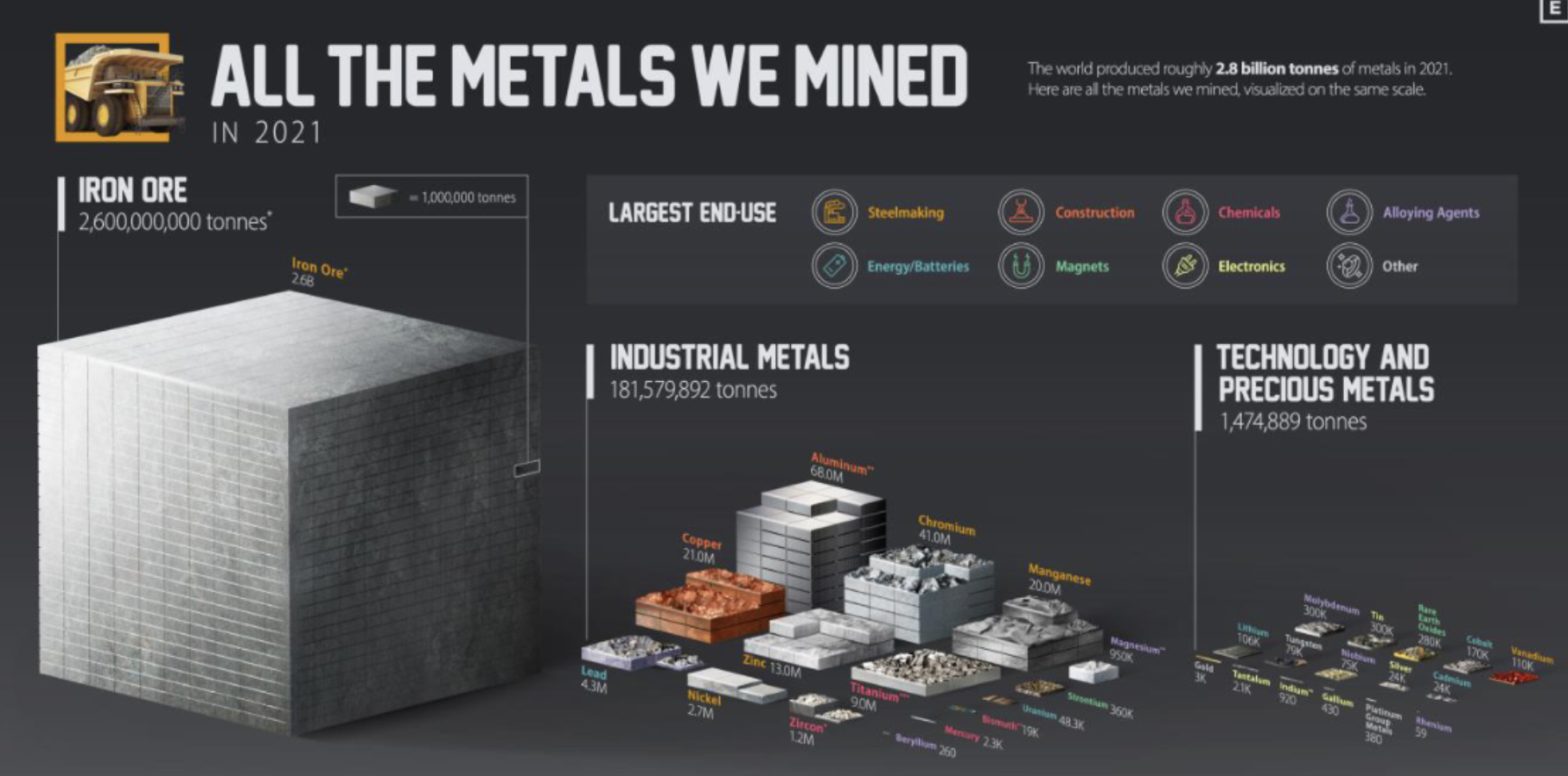
Nuclear fission power pros/cons (65-67)
Uranium
Occurs naturally in all rocks.
Used for nuclear energy production.
Its turned into pellet or rod form and placed in a nuclear reactor.
Uranium has two major isotopes
99.3% is U238 (not fissionable)
0.7% is U235 (must be enriched 2-3 times to be fissionable, most common).
Power plants
Nuclear power derives energy from breaking apart atomic nuclei.
Fission splits a large nucleus into smaller fragments, produces a lot of energy.
As fission takes place, pipes run water alongside the reaction structure, which heats the water and transforms it into high pressure steam.
Steam goes to a turbine, which drives a dynamo that generates electricity.
Nuclear concerns
Nuclear meltdown
Release of mass amounts of radiation
Nuclear waste - spent fuel rods contain radioactive elements (emits gamma rays and x-rays).
Stored in containers to last for thousands of years when the half lives wear out and fully decay.
Material put in Yucca Mountain
Stored on site at power plant, but waste stays hot, which can cause material to leak into air, water, and environment.
Lithium (68)
Electric vehicles (EVs) are skyrocketing the demand for lithium mining.
Lithium mining in Nevada, takes place by pumping brines to the surface and concentrating the minerals through the evaporative process.
1.5-2 years, and lithium carbonate sands are retrieved.
Raw material is sent to be processed into lithium-ion batteries.
Formation of metal ore deposits (70)
Tectonic processes are the dominant control (another reason plate tectonics are important).
Igneous and hydrothermal activity occur at tectonic plate boundaries, along rifts, and at hot spots.
They are the places where most mineral resources form.
Tectonic effects are then overprinted by the influence of the hydrologic cycle.
Ore reserves in the United States won’t exceed 50 years.
Critical minerals used for renewables (80)
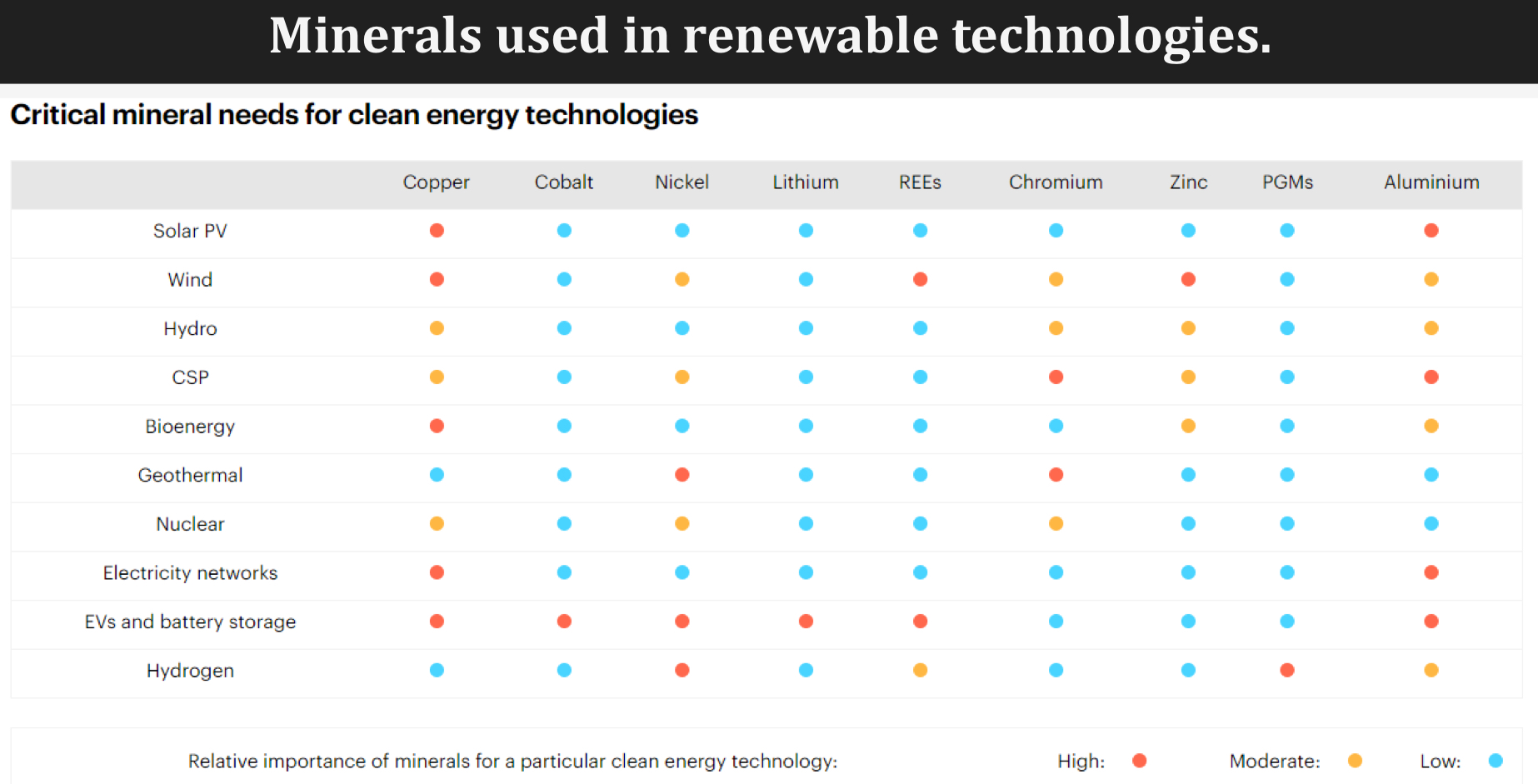
Renewable energy (79, 82, 83, 84)
Renewable energy sources help the environment.
Fossil fuels are finite (limited reserves).
Wind power (renewable, CO2 free)
Kinetic energy from wind turns to mechanical energy as it drives turbines
Average wind speed in a year is a critical factor in wind energy.
Wind farms have negative aesthetic impacts, blades are nosy, obstruct bird routes.
Solar power
Most abundant source of energy.
Can be used in any area, more efficient in some.
Depends upon insolation, variable on a seasonal and daily basis.
Two ways to use solar energy directly:
Solar collectors concentrate sunlight for heating.
Photovoltaic (PV) cells convert light directly into electricity.
Hydroelectric
Flowing water turns potential energy into kinetic energy as water passes turbines.
Positive aspects: dams reduce risk of floods, impound water for drinking, irrigation, less waste.
Negative aspects: dams destroy valued landscapes and alter ecosystems, trap sediment that requires expensive dredging, and accelerate erosion downstream.
Breach can result massive flooding.
Nuclear fusion energy (89)
Hydrogen fusion, like the sun.
Limitless clean power, releases ~4 million times more energy than fossil fuels.
Used mostly in research (`20 fusion reactors in the world), work being done on developing ways to confine the reaction and harness the energy.
Best long-term option for clean power (minerals may run out for renewables and require a lot of maintenance).
Renewable leaders (91)
China is leading in the main renewables
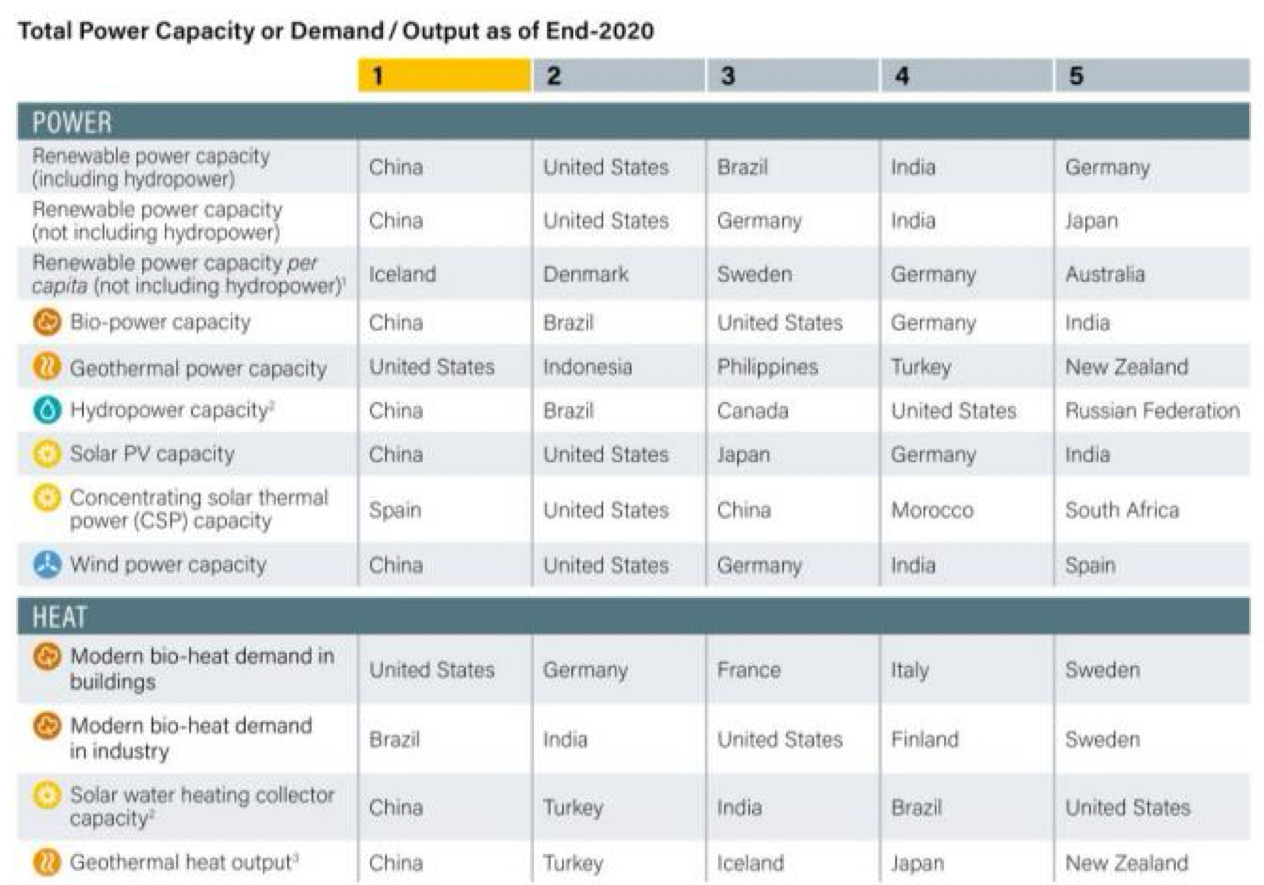
Challenges and the future of renewables (96, 97)
Fossil fuels are subsidized (not a level playing field).
Capital cost of renewable energy production is high (residential and large project).
Supportive regulatory framework needs to push forward.
Resource availability must be considered
Technological advancements needed in storage capacity
Supporting infrastructure needed.
Gris updates
EV charging stations
Renewables require fossil fuels to manufacture and transport.
Carbon footprint is decreasing.

Chapter 19: Global Change to the Earth System
Earth’s changing climates through time (2)
Geologists have reconstructed an approximate record of global climate for geologic time.
Global climate history has oscillated between warmer greenhouse periods and colder icehouse periods.
Modern actions with burning of fossil fuels have altered natural fluctuations of Greenhouse Gases (GHGs like carbon dioxide and methane).
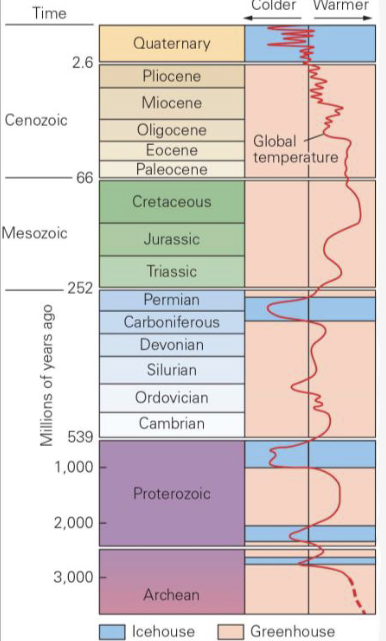
How GHGs work to warm climate (3)
Incoming solar energy from the Sun penetrates the atmosphere and warms Earth’s surface.
The absorbed energy is released from the surface as infrared (thermal) energy.
Greenhouse effect: certain gases (H2O, CO2, CH4, NO2) in Earth’s atmosphere absorb thermal energy and re-radiate it, warming the lower atmosphere.
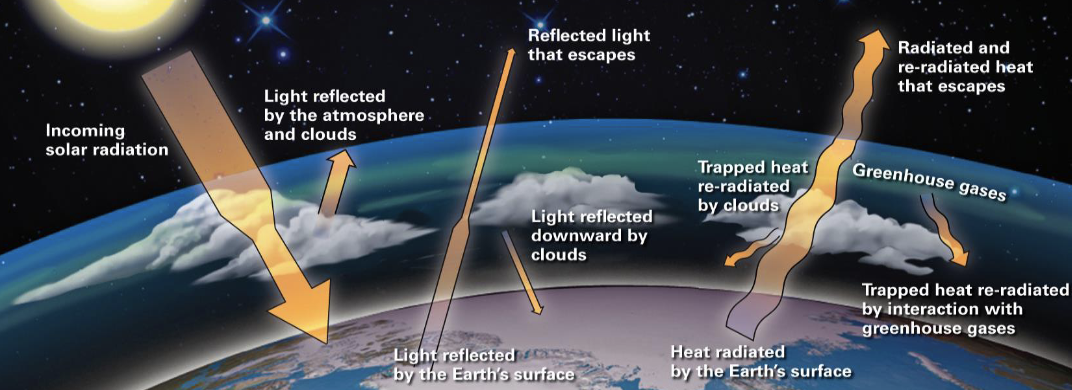
GHG natural emissions and sinks (4)
Without greenhouse gases, earth would be dead and frozen
Water is the most important greenhouse has. Carbon dioxide is second.
Processes that increase the amount of greenhouse gases warms the atmosphere.
Processes that removes greenhouse gases cools the atmosphere.
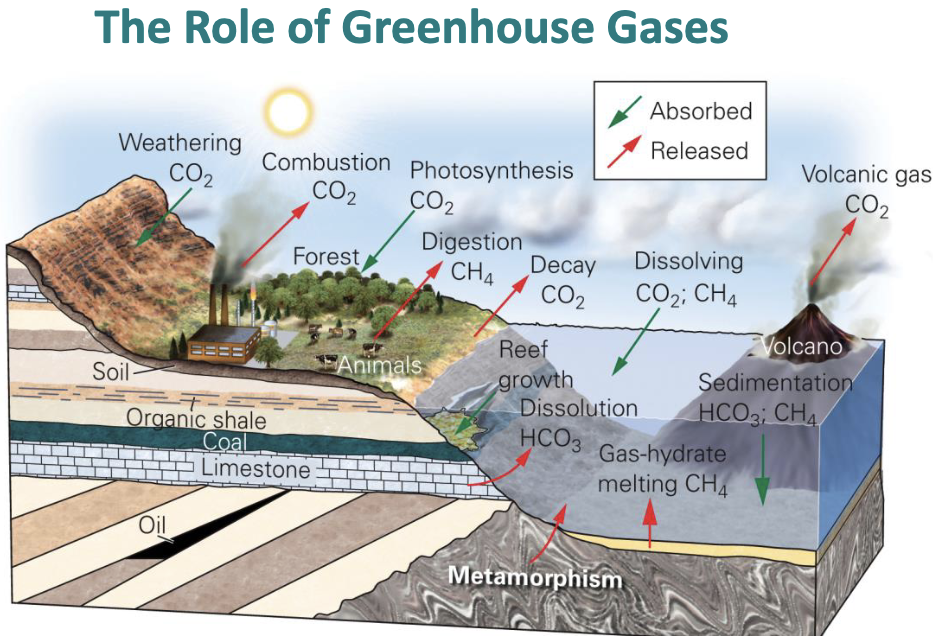
CO2 (carbon dioxide) sources and trends (5, 6)
Rapid industrialization, resource extraction, energy use, deforestation, transportation.
Human GHG emissions have results in CO2 in the atmosphere to have steadily increased since the start of the Industrial Revolution.
Annual oscillation reflects CO2 removal by plants in the northern hemisphere summer.

CH4 (methane) sources and trends (7, 8)
Humans have increased greenhouse gas methane (CH4)
Methane is 23x more potent of a GHG than CO2.
CH4 concentrations have found to be increasing in the same trend as CO2.
Agriculture practices and livestock, fossil fuels, deforestation.

GHG correlation to temperature (9)
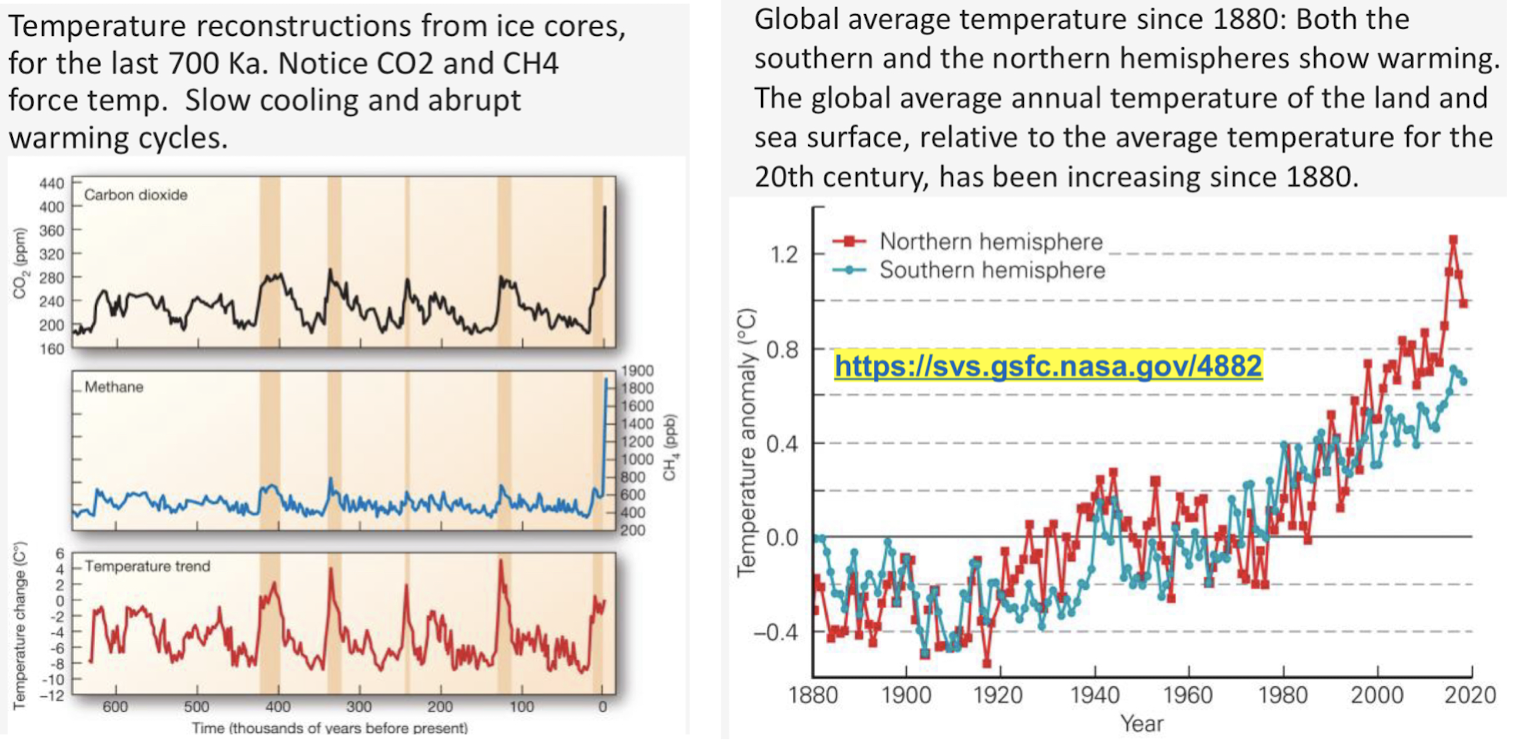
Examples of impacts related to forced climate change (10)
Changes in seasonality
Rising global average temperatures
Melting ice sheets
Rising sea levels
Unpredictable weather patterns
Increased intensity of extreme weather events
Long-term droughts
Land degradation
Loss of biodiversity
Climate refugees
Increased risk of diseases
Global food and water shortages
Climate wars